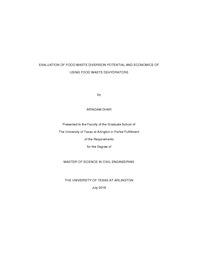
ATTENTION: The works hosted here are being migrated to a new repository that will consolidate resources, improve discoverability, and better show UTA's research impact on the global community. We will update authors as the migration progresses. Please see MavMatrix for more information.
Show simple item record
| dc.contributor.advisor | Hossain, Sahadat | |
| dc.creator | Dhar, Arindam | |
| dc.date.accessioned | 2016-10-25T19:32:43Z | |
| dc.date.available | 2016-10-25T19:32:43Z | |
| dc.date.created | 2016-08 | |
| dc.date.issued | 2016-08-12 | |
| dc.date.submitted | August 2016 | |
| dc.identifier.uri | http://hdl.handle.net/10106/26126 | |
| dc.description.abstract | According to US EPA (2013), food waste is the second largest component (14.6%) of MSW composition in the US, preceded only by paper. Apart from the negative environmental impacts of food waste through methane and leachate generation, it also incurs huge cost to landfill them. Hence, food waste diversion from landfills is becoming a
major issue in landfills across many US states. Though biological treatment of food waste is a potential alternative for food waste diversion, the existing scale of this type of treatment is very narrow. On-site treatment of food waste is a suitable alternative as it can be adopted across any scale. Among the on-site food waste treatment technologies,
condensate water.
In the current study, a total of 8 samples were collected from 4 different sources
dehydrators present a sustainable benefit due to the retention of nutrient values in its
output. However, no systematic studies has been undertaken to identify the diversion
potential of food waste dehydrators and sustainable usage of its end products. Therefore,
the objective of this study is to evaluate the potential of dehydrators to divert food waste
from the landfill and propose sustainable usage of its end products, dry food waste and
to characterize the composition, moisture content and unit weight of the food waste samples. The food wastes were found to consist mostly of fruits and vegetables and grain products, with fruits and vegetable being the major component in most of the samples. The moisture content and the unit weight of the samples were found to vary between 63- 87% and 1373-1828 lb/yd3 respectively. The food waste dehydrator achieved a weight loss of 53-91% depending on sample sources. The dehydrator operation was found to be economically feasible for weight loss percentage more than 53% in the study conditions. The study also revealed that for the case of City of Denton Landfill, even a 50% food waste diversion to dehydrator may lead to daily airspace gain of 9 yd3, valued at $ 185. The dry food waste was tested for its unit weight, particle size distribution, pH and C/N
ratio and was found to possess the qualities of an ideal compost feedstock. The condensate water was tested for its pH, turbidity, BOD5, fecal coliform and enterococci to determine its usability as reclaimed water according to TCEQ regulations. Though the condensate water had acceptable quality parameters in all other categories, it was found to have exceedingly high BOD5 (2200 – 9250 mg/l) and should be treated for BOD5 removal before it can be used as reclaimed water. Also, the food waste dehydrator was found to be more efficient and economical than the other available on-site food waste processing alternatives. | |
| dc.format.mimetype | application/pdf | |
| dc.language.iso | en_US | |
| dc.subject | Municipal solid waste | |
| dc.subject | Food waste | |
| dc.subject | Diversion from landfill | |
| dc.subject | On-site treatment | |
| dc.subject | Food waste dehydrator | |
| dc.subject | Diversion potential | |
| dc.subject | Diversion economics | |
| dc.subject | Sustainability | |
| dc.subject | Composting | |
| dc.title | EVALUATION OF FOOD WASTE DIVERSION POTENTIAL AND ECONOMICS OF USING FOOD WASTE DEHYDRATORS | |
| dc.type | Thesis | |
| dc.degree.department | Civil Engineering | |
| dc.degree.name | Master of Science in Civil Engineering | |
| dc.date.updated | 2016-10-25T19:32:58Z | |
| thesis.degree.department | Civil Engineering | |
| thesis.degree.grantor | The University of Texas at Arlington | |
| thesis.degree.level | Masters | |
| thesis.degree.name | Master of Science in Civil Engineering | |
| dc.type.material | text | |
Files in this item
- Name:
- DHAR-THESIS-2016.pdf
- Size:
- 4.581Mb
- Format:
- PDF
This item appears in the following Collection(s)
Show simple item record


